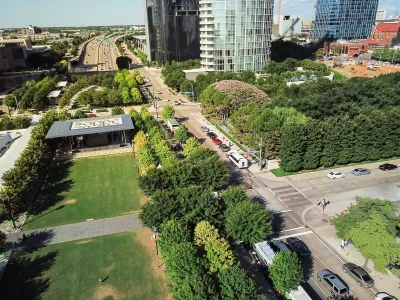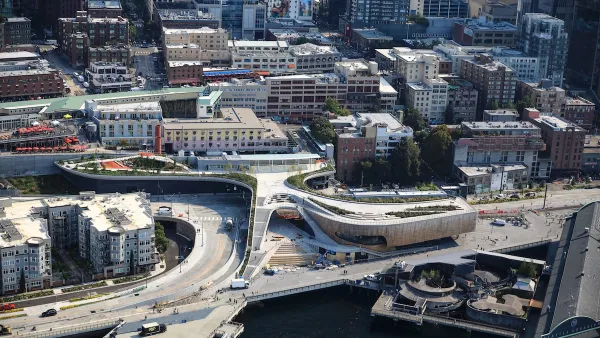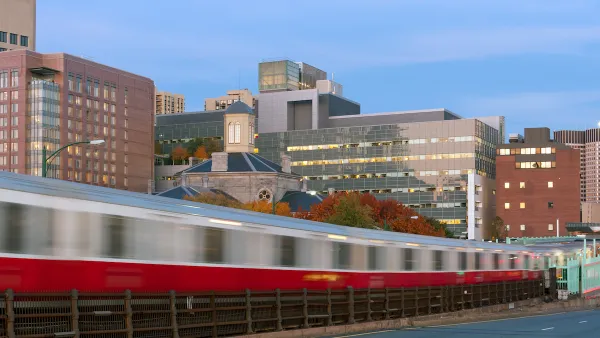How freeway capping projects can literally and metaphorically bridge urban divides.

As Austin prepares to cap portions of Interstate 35 to remedy the highway’s disruptive effect on downtown and provide useful new land for its medical complex, it might look out of town to a few other successful models.
In Dallas, as part of a team gathered by civic leaders, some of whose real estate assets bordered the gash created by the noisy (but sunken) Woodall Rodgers Expressway, we made sure to program the resulting above-ground pad quite robustly. Austin, too, will not want to be content with just a field of green; there must be activities galore to draw crowds of visitors.
There are many unforeseen benefits of the Klyde Warren Park project in Dallas. The city’s cultural center is now linked to the thriving uptown office district across the capped highway. And in a city where a civic booster once described the “walking radius” to me as about 75 yards, an impressive number of Dallasites is moving around on foot to get to events, picnics, and lunch business meetings in the park.
We often start with sure-fire winners like fitness classes, live music and dance performances, games, and food and beverage kiosks. Highly educated cities like Austin will appreciate lectures and lessons including book talks, screenwriting workshops, and poetry readings. Programming of this kind can attract sponsors, as it has in our non-deck parks like Bryant Park in New York. And the cap project in Austin needs a plan for multiple revenue sources beyond government support, which may waver at times. Assessments on abutting property owners, fees for commercial events, and rents paid by food vendors are some likely possibilities.
Once the new cap park is launched, its operator must gather data to support its outreach to sponsors. New devices can provide precise visitor counts and measure the percentage of female visitors, a proxy for the public’s perception of the park’s safety. Continually cleaned restrooms with features like flower displays, classical music playing, and wall-mounted art, as well as functional features like child changing tables, can also entice more women visitors and families.
From projects we’ve managed that don’t cover a highway, we’ve learned a few other lessons. Lush landscaping, with more emphasis on mature trees and shrubs than on elaborate stonework, has led to the popularity of Salesforce Park in downtown San Francisco. That space, placed on top of a new bus terminal, long and rectangular like a cap park, has become a huge draw for office workers on breaks and business “walking meetings,” even as the rest of the city’s “south of Market” area has suffered due to remote work policies and street disorder.
Deck parks are being planned across the country, particularly in red states like Texas more than in blue states, which tend to inflate construction costs of such projects with very costly labor rules. Since all major cities suffer from problems with noise and air pollution caused by expressways that slice through their — often lowest-income — neighborhoods, policies that limit cap park development often harm low-income citizens the most.
For example, a group of local members of the Urban Land Institute have combined in a recent advisory panel and report to design a group of caps over the very loud and polluting Cross Bronx Expressway, which damages several neighborhoods in the Central Bronx in New York. As a member of that group, I am skeptical about the timely building of that solution not due to any flaws in the concept, but due to the out-of-control construction cost inflation New York legislators insist upon.
One more thing: the best leaders of highway-capping efforts often are a mixture of adjacent property owners whose asset values stand to benefit, leaders of downtown management groups, and philanthropists, like the Grant family in Dallas. Representatives of local government collaborating with such entities best have some pre-existing ties to those private sector leaders.
Those of us who have taken on civic challenges that seemed at first insurmountable should leap in with plans to cover highways of all kinds, not just interstates, which have weakened our inner city and suburban neighborhoods.
Dan Biederman is the president of Biederman Redevelopment Ventures, a nationally recognized leader in the creation and revitalization of parks, public spaces, streetscapes, and business improvement districts.

National Parks Layoffs Will Cause Communities to Lose Billions
Thousands of essential park workers were laid off this week, just before the busy spring break season.

Retro-silient?: America’s First “Eco-burb,” The Woodlands Turns 50
A master-planned community north of Houston offers lessons on green infrastructure and resilient design, but falls short of its founder’s lofty affordability and walkability goals.

Delivering for America Plan Will Downgrade Mail Service in at Least 49.5 Percent of Zip Codes
Republican and Democrat lawmakers criticize the plan for its disproportionate negative impact on rural communities.

Test News Post 1
This is a summary

Test News Headline 46
Test for the image on the front page.

Balancing Bombs and Butterflies: How the National Guard Protects a Rare Species
The National Guard at Fort Indiantown Gap uses GIS technology and land management strategies to balance military training with conservation efforts, ensuring the survival of the rare eastern regal fritillary butterfly.
Urban Design for Planners 1: Software Tools
This six-course series explores essential urban design concepts using open source software and equips planners with the tools they need to participate fully in the urban design process.
Planning for Universal Design
Learn the tools for implementing Universal Design in planning regulations.
EMC Planning Group, Inc.
Planetizen
Planetizen
Mpact (formerly Rail~Volution)
Great Falls Development Authority, Inc.
HUDs Office of Policy Development and Research
NYU Wagner Graduate School of Public Service





























